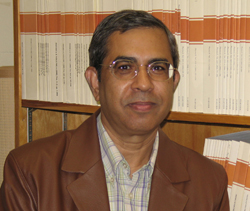Putting a new spin on spintronics
Groundbreaking work by a team of theoretical physicists at the University of Manitoba could bring the futuristic world of spin electronics one step closer to reality. The research, recently published in the American Physical Society’s prestigious journal, Physical Review Letters, solves one of the major problems in this fast-growing field.
 |
| Tapash Chakraborty, Canada Research Chair in Nanoscale Physics. |
In current transistor technology, from the simplest household gadget to the most sophisticated super computer, information is transported by the charge of electrons. With spin electronics, or “spintronics”, scientists are looking at ways to transport information using the spin of electrons, which could lead to much faster processing speeds, lower electrical power consumption, and greatly reduced size for electronic devices.
“Spintronics could really revolutionize our concept of what can be done with electronics,” said Tapash Chakraborty, Canada Research Chair in Nanoscale Physics. “For example, spintronics would play a major role in the development of quantum computers that could solve in a matter of seconds things that would take our current classical computers years to complete.”
Chakraborty’s team is studying the interaction of electron spins in quantum dots, tiny semiconductors measuring only a few nanometers in diameter. In quantum dots, scientists can inject one electron at a time, and the spin of each electron is very well defined.
“If you have a quantum dot with two to four electrons, the major challenge is finding a way to manipulate electron spin, control it, and detect it at the end,” he said. “There are discrete energy levels in quantum dots, and you need a certain energy for an electron to jump from one level to the next. When that happens, the electron emits light which can be seen using far infra-red spectroscopy.”
Chakraborty and his team constructed huge, one million by one million “monster matrices” to calculate the probabilities of electron spin jumping from one level to another. Using the monster matrices, the team was able to define all of the energy levels in quantum dots containing one to four electrons, including all of the possible transitions.
Chakraborty’s team is one of only a few groups in the world capable of this kind of computation, and they were the first one to solve it.
“We now have results that provide an accurate prediction of all of the transitions that will take place, including the effects that experimentalists will see in the laboratory,” Chakraborty said. “For the first time, in the context of spin control, we have shown exactly how these electrons will behave, and we have mapped out their optical signatures.”
Chakraborty now plans to extend this research by looking at systems of two coupled quantum dots. These coupled systems will be necessary to generate the quantum bits that will be used in the quantum computers of the future.
For more
information:
Frank Nolan
Research Promotion Officer
Office of the Vice-President (Research)
P:(204) 474-7300
F:(204) 261-3475
E: fnolan@ms.umanitoba.ca
news
Sep 2Building a Better High-Tech Polymer
Aug 26
'In the genomics game'
events
Sep 12 - 9:00 am
NSERC Scholarships and Fellowships workshop
Sep 13 - 9:00 am
SSHRC SITE VISIT
 474
474